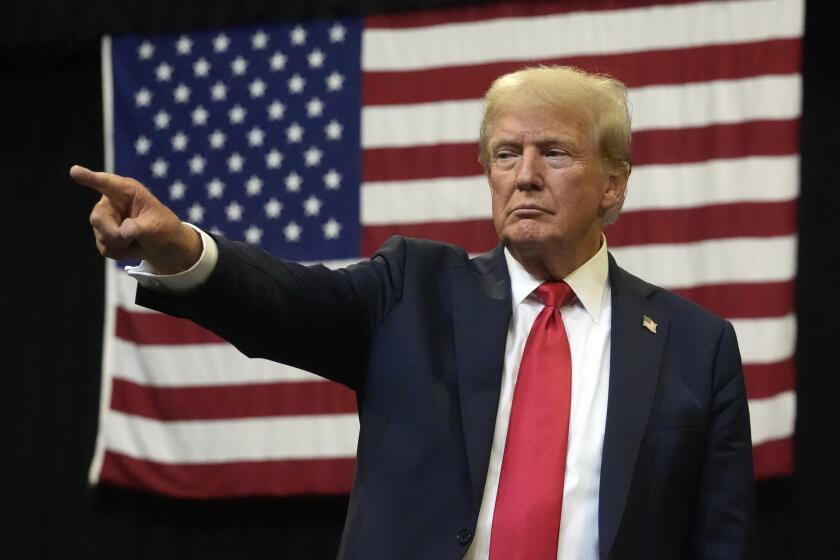Miers’ Answer Raises Questions
Asked to describe the constitutional issues she had worked on during her legal career, Supreme Court nominee Harriet E. Miers had relatively little to say on the questionnaire she sent to the Senate this week.
And what she did say left many constitutional experts shaking their heads.
At one point, Miers described her service on the Dallas City Council in 1989. When the city was sued on allegations that it violated the Voting Rights Act, she said, “the council had to be sure to comply with the proportional representation requirement of the Equal Protection Clause.”
But the Supreme Court repeatedly has said the Constitution’s guarantee of “equal protection of the laws” does not mean that city councils or state legislatures must have the same proportion of blacks, Latinos and Asians as the voting population.
“That’s a terrible answer. There is no proportional representation requirement under the equal protection clause,” said New York University law professor Burt Neuborne, a voting rights expert. “If a first-year law student wrote that and submitted it in class, I would send it back and say it was unacceptable.”
Stanford law professor Pamela Karlan, also an expert on voting rights, said she was surprised the White House did not check Miers’ questionnaire before sending it to the Senate.
“Are they trying to set her up? Any halfway competent junior lawyer could have checked the questionnaire and said it cannot go out like that. I find it shocking,” she said.
White House officials say the term “proportional representation” is “amenable to different meanings.” They say Miers was referring to the requirement that election districts have roughly the same number of voters.
In the 1960s, the Supreme Court adopted the “one person, one vote” concept as a rule under the equal protection clause. Previously, rural districts with few voters often had the same clout in legislatures as heavily populated urban districts. Afterward, their clout was equal to the number of voters they represented. But voting rights experts do not describe this rule as “proportional representation,” which has a specific, different meaning.
“Either Miers misunderstood what the equal protection clause requires, or she was using loose language to say something about compliance with the one-person, one-vote rule,” said Richard L. Hasen, a professor at Loyola Law School in Los Angeles who specializes in election law. “Either way, it is very sloppy and unnecessary. Someone should have caught that.”
Proportional representation was a focus of debate in the early 1980s. Democrats and liberal activists were pressing for Congress to change the Voting Rights Act to ensure minorities equal representation on city councils, state legislatures and in the U.S. House.
They were responding to a 1980 case in which the Supreme Court upheld an election system in Mobile, Ala., that had shut out blacks from political power. The city was governed by a council of three members, all elected citywide. About two-thirds of voters were white and one-third black, but whites held all three seats.
The Supreme Court said Mobile’s system was constitutional, so long as there was no evidence it had been created for a “discriminatory purpose.”
“The equal protection clause does not require proportional representation,” the court said in a 6-3 decision. In dissent, Justice Thurgood Marshall said the decision gave blacks the right to cast “meaningless ballots.”
In response, Congress moved to change the Voting Rights Act to permit challenges to election systems that had the effect of excluding minorities from power. The Reagan administration opposed those efforts, saying they would lead to a proportional representation rule.
Congress adopted a hazy compromise in 1982. It said election systems could be challenged if minorities were denied a chance “to elect representatives of their choice.... Provided that nothing in this section establishes a right to have members of a protected class elected in numbers equal to their proportion of the population.”
This law put pressure on cities such as Dallas and Los Angeles and many states to redraw their electoral districts in areas with concentrations of black or Latino voters. The number of minority members of Congress doubled in the early 1990s after districts were redrawn.
In Dallas, Miers supported a move to create City Council districts so black and Latino candidates would have a better chance of winning seats.
“She came to believe it was important to achieve more black and Hispanic representation,” Hasen said. “She could have a profound impact as a justice if she brought that view to the court. So from the perspective of the voting rights community, they could do a lot worse than her.”
White House spokeswoman Dana Perino also emphasized that Miers’ experience was more important than her terminology.
“Ms. Miers, when confirmed, will be the only Supreme Court Justice to have actually had to comply with the Voting Rights Act,” she said.
More to Read
Get the L.A. Times Politics newsletter
Deeply reported insights into legislation, politics and policy from Sacramento, Washington and beyond. In your inbox three times per week.
You may occasionally receive promotional content from the Los Angeles Times.











